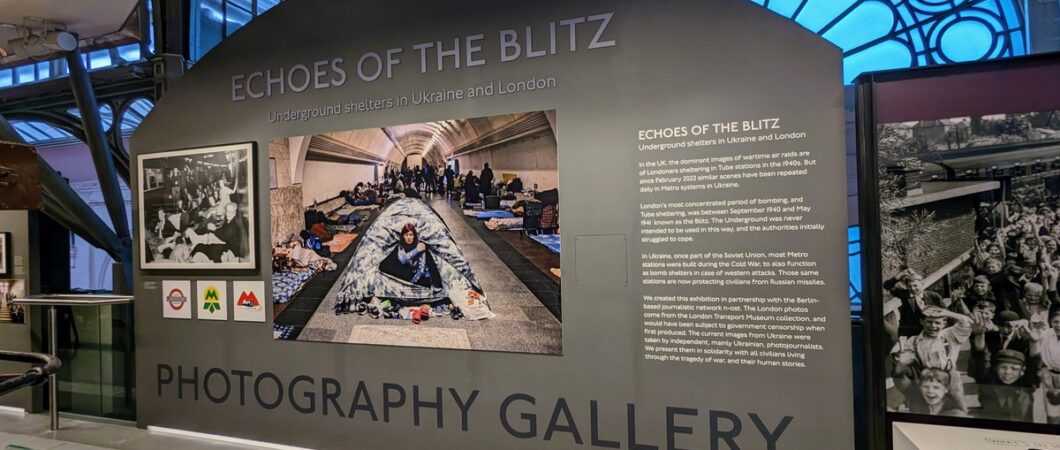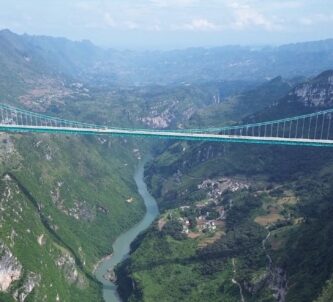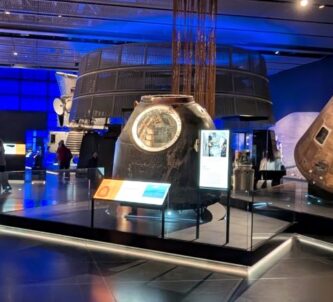A new photographic exhibition, Echoes of the Blitz: Underground shelters in Ukraine and London, is opening at the London Transport Museum tomorrow (Fri 1st March 2024).
The exhibition compares and contrasts 70 wartime images taken almost 80 years apart in the Tube stations of London and the Metro Stations of Ukraine. The clothes may be different but the look of anxiety, fear, exhaustion, and resilience on the faces of 1940s Londoners and Ukrainian civilians in 2022, are the same.
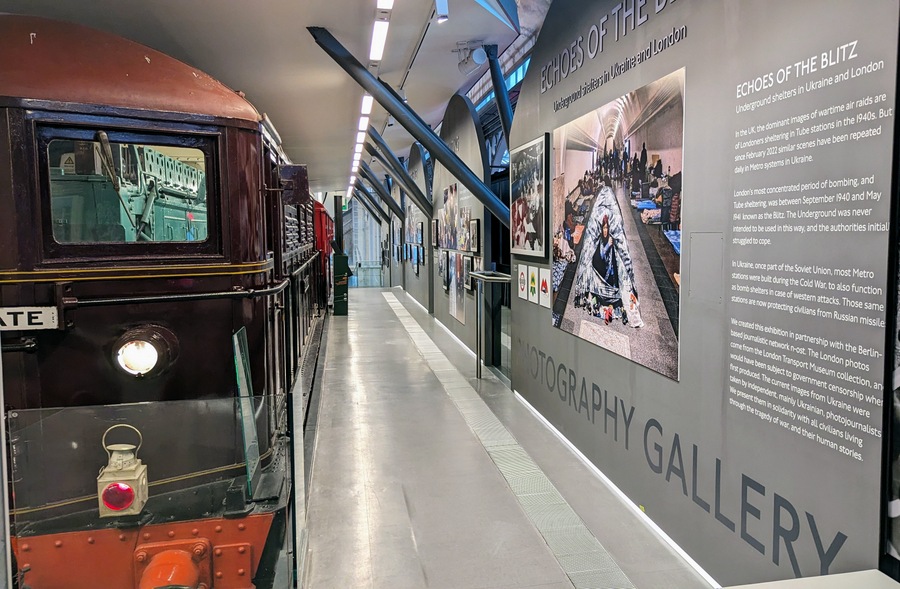
The exhibition is a collaboration between the London Transport Museum and n-ost, a Berlin-based non-profit network of journalists who specialise in reporting on Eastern Europe. It matches historical images from the museum’s collection, with 38 contemporary photographs by six renowned, mainly Ukrainian, documentary photographers.

Most of the photographs taken in the London Underground were shot during the period of peak bombing: Sep 1940 – May 1941, aka The Blitz. The photos taken in the underground Metro stations of Kyiv and Karkiv have been taken from the very first day of the present war: 24 Feb 2022*. They show civilians establishing themselves in their underground shelters.
London’s air raid sirens sounded almost every day during the eight months of the Blitz, so sheltering in Tube stations overnight became a routine. There were special admission tickets, bunk beds on the platforms, refreshments and, at some stations, libraries, music and live entertainment.
In Kyiv, sheltering in the Metro peaked at around 40,000 people at the beginning of the Russian invasion. Some people stayed overnight, others for days or weeks, returning to the surface only for groceries or to wash. Those who lost their homes lived underground for months.
Kharkiv, close to the border with Russia, experiences more frequent shelling. People spent more time in the Metro there, creating, just like their British predecessors, comfortable homely spaces with bedding, tents, carpets, decorations and toys.
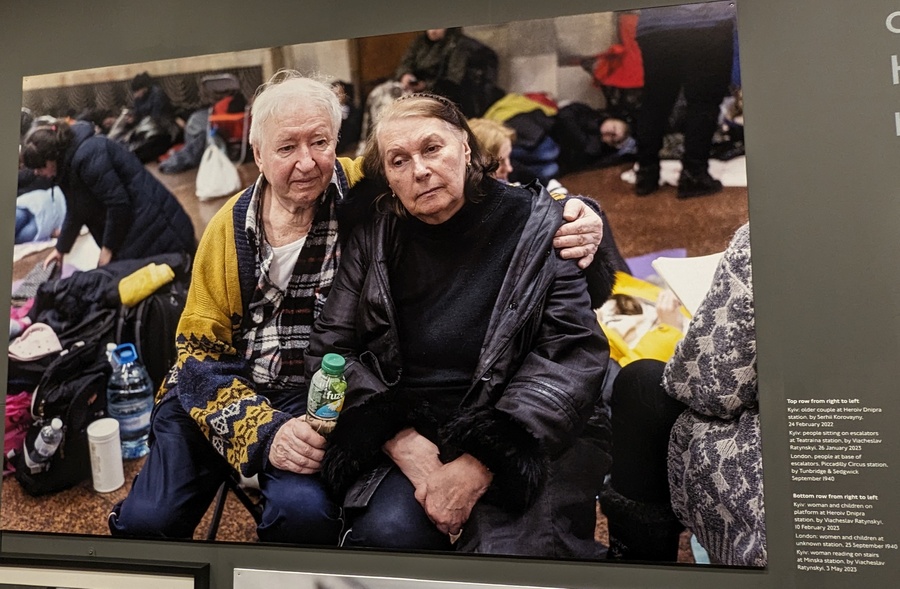
And they share the same thoughts…
“I hated it to be quite frank. The idea of going down night after night. Home – shelter – home – shelter.” – Len Phillips, London shelterer, 1941-45
“At night, we went down to the Metro, and in the morning, we returned to the restaurant, where we prepared breakfasts and lunches for people sheltering underground. We only paused if we heard an explosion.” Oleksandra ______, manager of voluntary kitchen and restaurant, Kyiv, 2023.
One interesting difference, comes in the way these stories are told.
The London photos of underground shelters would have been subject to government censorship when first produced. By contrast, the current images from Ukraine were taken by independent, mainly Ukrainian, photojournalists.
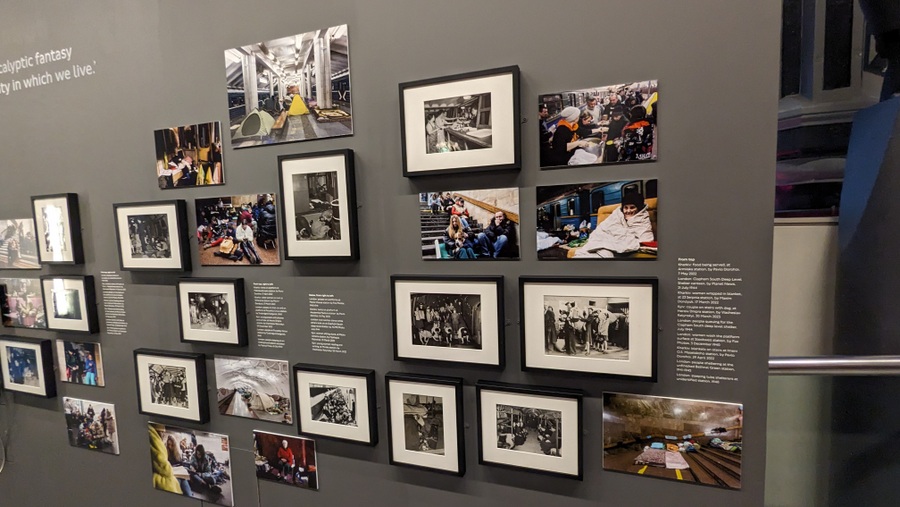
At first, during the Second World War, the UK Government was opposed to letting people shelter in Tube stations as it believed keeping trains running was more important. However, following the sheer numbers of civilians heading below ground and protests from the press and Parliament, the authorities were forced to make a U-turn.
So the work of the British press photographers was directed and, where necessary, censored to promote an image of Londoners united against the Blitz. This contrasts with the hard-hitting, realistic photo-journalism of the independent Ukrainian photographers** that visitors will see today.
The exhibition runs along one wall on the second floor and will remain on display until spring 2025.
* Viacheslav Ratynskyi, a photographer featured in the exhibition said: “On the first day of the Russian invasion on 24 February 2022 I went down into the Metro for the first time. As I listened to the air-raid siren, I decided to take shelter there and to bring a camera with me so I could document the situation.“
** The present-day photographers with work featured in the exhibition are:
- Pavlo Dorohoj (Ukrainian) https:IIwww.instacram.com/pavlodorohoj/
- Viacheslav Ratynskyi (Ukrainian) https:llwww.viacheslavratynskyi.com
- Serhii Korovayny (Ukrainian) http://www.korovayny.com
- Maxim Dondyuk (Ukrainian) https:llmaximdondyuk.com
- Mykhaylo Palinchak (Ukrainian) https://palinchak.com.ua
- Emile Ducke (German) https:llemileducke.de
Factbox
Getting there: London Transport Museum
Covent Garden Piazza
London WC2E 71313.
It’s easy to get to. The nearest Tube stations are Covent Garden or Leicester Square, then Charing Cross, Embankment, or Holborn. The nearest bus stops are Strand or Aldwych
Entry Price (Jul 2024):
The museum has a weird ticketing system. If you are 18 or over, you have to buy an Annual Pass and then you can book your timed entry ticket. Or you can think of it the other way around: you buy your ticket, (the price is not dissimilar to other London attractions) and get the added bonus of being able to return for free anytime in the next 12 months.
There are three types of Annual Pass:
Unlimited – Unlimited daytime entry to the Museum in Covent Garden for a whole year.
Off Peak Annual Pass – Entry to the Museum on weekdays after 2pm (term-time and summer holidays only for a discounted price).
Annual Pass Plus – Unlimited daytime entry to the Museum in Covent Garden plus free entry for you and two children at their Depot Open Days in Acton.
| Unlimited Annual Pass | Adult | £24.50 |
| Concession | £23.50 | |
| Local Resident | £18.50 | |
| Universal Credit/Pension | £1.00 | |
| Off-peak Annual Pass | Adult | £22.50 |
| Annual Pass + | Adult | £70.00 |
Opening Hours:
The museum is open daily from 10:00-18:00

